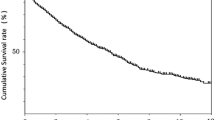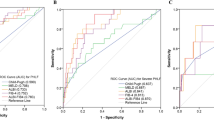Abstract
Background and Aims
The Child-Pugh (CP) score is a widely used method to assess liver function and predict postoperative outcomes in patients with hepatocellular carcinoma (HCC). Recently, the fibrosis index (FIB-4) has been demonstrated to be closely associated with liver fibrosis and cirrhosis. This study aimed to compare the capability of FIB-4 index with CP score in predicting the outcomes for HCC patients after hepatectomy.
Methods
A total of 495 HCC patients who underwent hepatectomy were enrolled. The performance of the FIB-4 index in predicting postoperative liver failure (PHLF) and overall survival was compared with that of the CP score.
Results
Of them, 9.3% (46/495) patients developed PHLF. The area under the receiver operating characteristic (ROC) curve of the FIB-4 index for predicting PHLF was greater than that of the CP score (0.744 versus 0.621; P = 0.044). The optimal cutoff value of the FIB-4 index for predicting PHLF was 4.16. Multivariable analyses revealed that the FIB-4 index was an independent predictor of PHLF regardless of the hepatectomy subgroups, but the CP grade was only a significant predictor of PHLF in the minor hepatectomy subgroup. The FIB-4 index (4.16) stratified patients into two distinct overall survival cohorts (P = 0.006). The FIB-4 index also classified patients with the Barcelona Clinical Liver Cancer (BCLC) stages 0 and A into two distinct overall survival cohorts (P = 0.001 and P = 0.034, respectively).
Conclusion
The FIB-4 index may be a better predictor of PHLF and overall survival in HCC patients with hepatectomy than CP score.





Similar content being viewed by others
References
Torre LA, Bray F, Siegel RL, Ferlay J, Lortet-Tieulent J, Jemal A. Global cancer statistics, 2012. CA Cancer J Clin 2015;65:87–108.
Zhong JH, Ke Y, Gong WF, Xiang BD, Ma L, Ye XP, Peng T, Xie GS, Li LQ. Hepatic resection associated with good survival for selected patients with intermediate and advanced-stage hepatocellular carcinoma. Ann Surg 2014;260:329–340.
Guo Z, Zhong JH, Jiang JH, Zhang J, Xiang BD, Li LQ. Comparison of survival of patients with BCLC stage A hepatocellular carcinoma after hepatic resection or transarterial chemoembolization: a propensity score-based analysis. Ann Surg Oncol 2014;21:3069–3076.
Kokudo T, Hasegawa K, Yamamoto S, Shindoh J, Takemura N, Aoki T, Sakamoto Y, Makuuchi M, Sugawara Y, Kokudo N. Surgical treatment of hepatocellular carcinoma associated with hepatic vein tumor thrombosis. J Hepatol 2014;61:583–588.
Vitale A, Burra P, Frigo AC, Trevisani F, Farinati F, Spolverato G, Volk M, Giannini EG, Ciccarese F, Piscaglia F, Rapaccini GL, Di Marco M, Caturelli E, Zoli M, Borzio F, Cabibbo G, Felder M, Gasbarrini A, Sacco R, Foschi FG, Missale G, Morisco F, Svegliati Baroni G, Virdone R, Cillo U, Italian Liver Cancer g. Survival benefit of liver resection for patients with hepatocellular carcinoma across different Barcelona Clinic Liver Cancer stages: a multicentre study. J Hepatol 2015;62:617–624.
El-Serag HB. Hepatocellular carcinoma. N Engl J Med 2011;365:1118–1127.
Ko S, Kanehiro H, Hisanaga M, Nagao M, Ikeda N, Nakajima Y. Liver fibrosis increases the risk of intrahepatic recurrence after hepatectomy for hepatocellular carcinoma. Br J Surg 2002;89:57–62.
Bruix J, Sherman M, American Association for the Study of Liver D. Management of hepatocellular carcinoma: an update. Hepatology 2011;53:1020–1022.
Durand F, Valla D. Assessment of the prognosis of cirrhosis: Child-Pugh versus MELD. J Hepatol 2005;42 Suppl:S100–107.
Vallet-Pichard A, Mallet V, Nalpas B, Verkarre V, Nalpas A, Dhalluin-Venier V, Fontaine H, Pol S. FIB-4: an inexpensive and accurate marker of fibrosis in HCV infection. comparison with liver biopsy and fibrotest. Hepatology 2007;46:32–36.
Sumida Y, Yoneda M, Hyogo H, Itoh Y, Ono M, Fujii H, Eguchi Y, Suzuki Y, Aoki N, Kanemasa K, Fujita K, Chayama K, Saibara T, Kawada N, Fujimoto K, Kohgo Y, Yoshikawa T, Okanoue T, Japan Study Group of Nonalcoholic Fatty Liver D.Validation of the FIB4 index in a Japanese nonalcoholic fatty liver disease population. BMC Gastroenterol 2012;12:2.
Xiao G, Yang J, Yan L. Comparison of diagnostic accuracy of aspartate aminotransferase to platelet ratio index and fibrosis-4 index for detecting liver fibrosis in adult patients with chronic hepatitis B virus infection: a systemic review and meta-analysis. Hepatology 2015;61:292–302.
Sterling RK, Lissen E, Clumeck N, Sola R, Correa MC, Montaner J, M SS, Torriani FJ, Dieterich DT, Thomas DL, Messinger D, Nelson M, Investigators AC. Development of a simple noninvasive index to predict significant fibrosis in patients with HIV/HCV coinfection. Hepatology 2006;43:1317–1325.
Toyoda H, Kumada T, Tada T, Kaneoka Y, Maeda A. A laboratory marker, FIB-4 index, as a predictor for long-term outcomes of hepatocellular carcinoma patients after curative hepatic resection. Surgery 2015;157:699–707.
Okamura Y, Ashida R, Yamamoto Y, Ito T, Sugiura T, Uesaka K. FIB-4 Index is a Predictor of Background Liver Fibrosis and Long-Term Outcomes After Curative Resection of Hepatocellular Carcinoma. Ann Surg Oncol 2016;23:467–474.
Dong J, Xu XH, Ke MY, Xiang JX, Liu WY, Liu XM, Wang B, Zhang XF, Lv Y. The FIB-4 score predicts postoperative short-term outcomes of hepatocellular carcinoma fulfilling the milan criteria. Eur J Surg Oncol 2016;42:722–727.
Forner A, Llovet JM, Bruix J. Hepatocellular carcinoma. Lancet 2012;379:1245–1255.
Bruix J, Reig M, Sherman M. Evidence-Based Diagnosis, Staging, and Treatment of Patients With Hepatocellular Carcinoma. Gastroenterology 2016;150:835–853.
Clavien PA, Petrowsky H, DeOliveira ML, Graf R. Strategies for safer liver surgery and partial liver transplantation. N Engl J Med 2007;356:1545–1559.
Johnson PJ, Berhane S, Kagebayashi C, Satomura S, Teng M, Reeves HL, O'Beirne J, Fox R, Skowronska A, Palmer D, Yeo W, Mo F, Lai P, Inarrairaegui M, Chan SL, Sangro B, Miksad R, Tada T, Kumada T, Toyoda H. Assessment of liver function in patients with hepatocellular carcinoma: a new evidence-based approach-the ALBI grade. J Clin Oncol 2015;33:550–558.
Pugh RN, Murray-Lyon IM, Dawson JL, Pietroni MC, Williams R. Transection of the oesophagus for bleeding oesophageal varices. Br J Surg 1973;60:646–649.
Chen X, Zhai J, Cai X, Zhang Y, Wei L, Shi L, Wu D, Shen F, Lau WY, Wu M. Severity of portal hypertension and prediction of postoperative liver failure after liver resection in patients with Child-Pugh grade A cirrhosis. Br J Surg 2012;99:1701–1710.
Rahbari NN, Garden OJ, Padbury R, Brooke-Smith M, Crawford M, Adam R, Koch M, Makuuchi M, Dematteo RP, Christophi C, Banting S, Usatoff V, Nagino M, Maddern G, Hugh TJ, Vauthey JN, Greig P, Rees M, Yokoyama Y, Fan ST, Nimura Y, Figueras J, Capussotti L, Buchler MW, Weitz J. Posthepatectomy liver failure: a definition and grading by the International Study Group of Liver Surgery (ISGLS). Surgery 2011;149:713–724.
Pol B, Campan P, Hardwigsen J, Botti G, Pons J, Le Treut YP. Morbidity of major hepatic resections: a 100-case prospective study. Eur J Surg 1999;165:446–453.
Schreckenbach T, Liese J, Bechstein WO, Moench C. Posthepatectomy liver failure. Dig Surg 2012;29:79–85.
Schindl MJ, Redhead DN, Fearon KC, Garden OJ, Wigmore SJ, Edinburgh Liver S, Transplantation Experimental Research G. The value of residual liver volume as a predictor of hepatic dysfunction and infection after major liver resection. Gut 2005;54:289–296.
Kudo M, Chung H, Haji S, Osaki Y, Oka H, Seki T, Kasugai H, Sasaki Y, Matsunaga T. Validation of a new prognostic staging system for hepatocellular carcinoma: the JIS score compared with the CLIP score. Hepatology 2004;40:1396–1405.
Ito T, Kumada T, Toyoda H, Tada T. FIB-4 index for assessing the prognosis of hepatocellular carcinoma in patients with Child-Pugh class A liver function. J Cancer Res Clin Oncol 2015;141:1311–1319.
European Association For The Study Of The L, European Organisation For R, Treatment Of C. EASL-EORTC clinical practice guidelines: management of hepatocellular carcinoma. J Hepatol 2012;56:908–943.
Esnaola N, Vauthey JN, Lauwers G. Liver fibrosis increases the risk of intrahepatic recurrence after hepatectomy for hepatocellular carcinoma (Br J Surg 2002; 89: 57-62). Br J Surg 2002;89:939–940; author reply 940.
Financial Support
This study was supported by the grants from the National Natural Science Foundation of China (No. 81773293 and No. 31660266), the Natural Science Foundation of Hunan Province (2015JJ4083 and 2018JJ3758), the Science and Technology Plan Fund in Hunan Province, P.R. China (2014WK2016, 2015GK3117, 2017DK2011, and 2017WK2063), and the Big Data Project of Xiangya Medical School, Central South University.
Author information
Authors and Affiliations
Contributions
Pan Zhou: data analysis and manuscript draft; Bo Chen: data collection and manuscript revision; Xiong-Ying Miao: administration and material support; Li Xiong: critical revision of the manuscript for important intellectual content; Jiang-Jiao Zhou: data acquisition; Yu Wen: administrative, technical, and material support and study supervision; Heng Zou: study concept and design
Corresponding author
Ethics declarations
The entire study protocol was approved by the Institutional Review Board of The Second Xiangya Hospital.
Conflict of Interest
The authors declare that they have no conflict of interest.
Additional information
Publisher’s note
Springer Nature remains neutral with regard to jurisdictional claims in published maps and institutional affiliations.
Electronic Supplementary Material
ESM 1
(DOCX 17.7 kb)
Rights and permissions
About this article
Cite this article
Zhou, P., Chen, B., Miao, XY. et al. Comparison of FIB-4 Index and Child-Pugh Score in Predicting the Outcome of Hepatic Resection for Hepatocellular Carcinoma. J Gastrointest Surg 24, 823–831 (2020). https://doi.org/10.1007/s11605-019-04123-1
Received:
Accepted:
Published:
Issue Date:
DOI: https://doi.org/10.1007/s11605-019-04123-1




